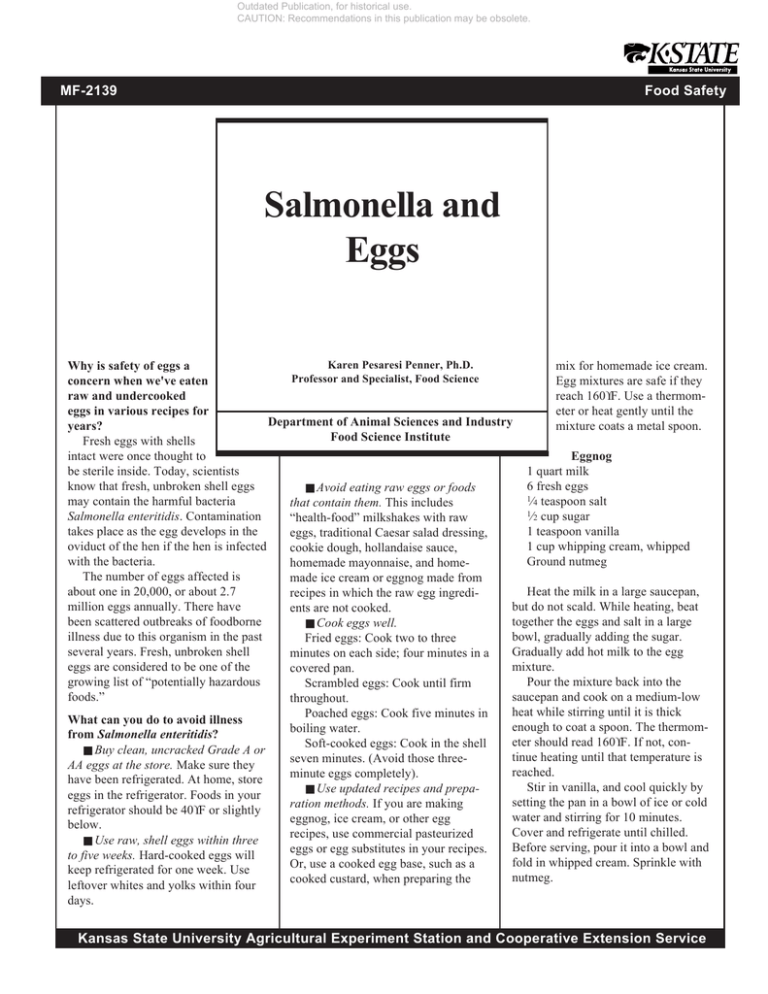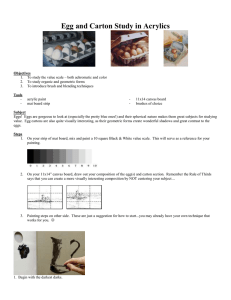
Outdated Publication, for historical use.
CAUTION: Recommendations in this publication may be obsolete.
MF-2139
Food Safety
Salmonella and
Eggs
Karen Pesaresi Penner, Ph.D.
mix for homemade ice cream.
Why is safety of eggs a
Professor and Specialist, Food Science
Egg mixtures are safe if they
concern when we've eaten
reach 160°F. Use a thermomraw and undercooked
eter or heat gently until the
eggs in various recipes for
Department of Animal Sciences and Industry
mixture coats a metal spoon.
years?
Food Science Institute
Fresh eggs with shells
Eggnog
intact were once thought to
1 quart milk
be sterile inside. Today, scientists
6 fresh eggs
know that fresh, unbroken shell eggs
■ Avoid eating raw eggs or foods
1⁄4 teaspoon salt
may contain the harmful bacteria
that contain them. This includes
1⁄2 cup sugar
Salmonella enteritidis. Contamination
“health-food” milkshakes with raw
1 teaspoon vanilla
takes place as the egg develops in the
eggs, traditional Caesar salad dressing,
1 cup whipping cream, whipped
oviduct of the hen if the hen is infected
cookie dough, hollandaise sauce,
Ground nutmeg
with the bacteria.
homemade mayonnaise, and homeThe number of eggs affected is
made ice cream or eggnog made from
Heat the milk in a large saucepan,
about one in 20,000, or about 2.7
recipes in which the raw egg ingredibut do not scald. While heating, beat
million eggs annually. There have
ents are not cooked.
together the eggs and salt in a large
been scattered outbreaks of foodborne
■ Cook eggs well.
bowl, gradually adding the sugar.
illness due to this organism in the past
Fried eggs: Cook two to three
Gradually add hot milk to the egg
several years. Fresh, unbroken shell
minutes on each side; four minutes in a
mixture.
eggs are considered to be one of the
covered pan.
Pour the mixture back into the
growing list of “potentially hazardous
Scrambled eggs: Cook until firm
saucepan and cook on a medium-low
foods.”
throughout.
heat while stirring until it is thick
Poached eggs: Cook five minutes in
What can you do to avoid illness
enough to coat a spoon. The thermomboiling water.
from Salmonella enteritidis?
eter should read 160°F. If not, conSoft-cooked eggs: Cook in the shell
■ Buy clean, uncracked Grade A or
tinue heating until that temperature is
seven minutes. (Avoid those threeAA eggs at the store. Make sure they
reached.
minute eggs completely).
have been refrigerated. At home, store
Stir in vanilla, and cool quickly by
■ Use updated recipes and prepaeggs in the refrigerator. Foods in your
setting the pan in a bowl of ice or cold
ration methods. If you are making
refrigerator should be 40°F or slightly
water and stirring for 10 minutes.
eggnog, ice cream, or other egg
below.
Cover and refrigerate until chilled.
recipes, use commercial pasteurized
■ Use raw, shell eggs within three
Before serving, pour it into a bowl and
eggs or egg substitutes in your recipes.
to five weeks. Hard-cooked eggs will
fold in whipped cream. Sprinkle with
Or, use a cooked egg base, such as a
keep refrigerated for one week. Use
nutmeg.
cooked custard, when preparing the
leftover whites and yolks within four
days.
Kansas State University Agricultural Experiment Station and Cooperative Extension Service
Outdated Publication, for historical use.
CAUTION: Recommendations in this publication may be obsolete.
Custard-based Ice Cream
1 egg, slightly beaten
1 cup milk
1⁄2 cup sugar
2 cups half and half or cream
1 pinch salt
11⁄2 teaspoons vanilla
Beat the egg just enough to mix.
Add sugar and salt, and stir the milk
into the egg mixture. Cook over hot,
not boiling, water, stirring constantly
until the mixture coats a spoon. Cool.
Add the cream and vanilla, and freeze
in an ice cream freezer.
What about eating those hardboiled, dyed Easter eggs?
Hard-boiled eggs that are to be
hidden for an egg hunt should not be
out of refrigeration for more than two
hours if you intend to eat them later.
Eggs may become cracked and dirty
from handling while hiding and
collecting.
Since cooking removes some of the
protective oil coating that processors
spray on the shells, bacteria can enter
the egg through the pores or cracks. As
a convenient alternative, you may want
to use plastic “eggs” for all the hunting
activities at your house.
Who should be extra careful to
avoid undercooked eggs?
The risk of foodborne illness from
eating raw eggs is particularly serious
for people who are vulnerable to
bacterial infections. These people
include the elderly whose immune
systems have weakened with age,
infants whose immune systems are
not fully developed, chronically ill
people with weakened immune
systems, and pregnant women
because of the risk to the fetus.
Elderly people are 10 times more
likely to die of foodborne illnesses
than younger adults whether they are
caused by Salmonella bacteria or
other foodborne pathogens. Of
foodborne illnesses in nursing
homes that could be traced to
specific organisms, Salmonella
bacteria, found most often in poultry
and eggs, caused 53 percent of the
outbreaks and 81 percent of the
deaths.
Brand names appearing in this publication are for product identification purposes only. No endorsement is intended,
nor is criticism implied of similar products not mentioned.
Publications from Kansas State University are available on the World Wide Web at: http://www.oznet.ksu.edu
Contents of this publication may be freely reproduced for educational purposes. All other rights reserved. In each case, credit
Karen Pesaresi Penner, Ph.D., Salmonella and Eggs, Kansas State University, April 2003.
Kansas State University Agricultural Experiment Station and Cooperative Extension Service
MF-2139
April 2003
It is the policy of Kansas State University Agricultural Experiment Station and Cooperative Extension Service that all persons shall have equal opportunity
and access to its educational programs, services, activities, and materials without regard to race, color, religion, national origin, sex, age or disability. Kansas State University is an equal opportunity organization. Issued in furtherance of Cooperative Extension Work, Acts of May 8 and June 30, 1914, as
amended. Kansas State University, County Extension Councils, Extension Districts, and United States Department of Agriculture Cooperating, Marc A.
Johnson, Director.







